“The future belongs to those who see possibilities before they become reality.”
If increased productivity and optimum performance are high on your agenda then you will be looking for a means to boost the driving force behind this your staff because.
– An effective work force consists of a healthy and vibrant team.
– An organization will thrive if its employees are motivated to give their best.
– An individual’s best will be determined by his/her overall state of health; physically, mentally and emotionally.
 Therefore employees’ overall health is a vital tool for increasing productivity and profits. Progressive companies has recognized this and making changes for the better for that they have started various means for helping employees to manage their health.
Therefore employees’ overall health is a vital tool for increasing productivity and profits. Progressive companies has recognized this and making changes for the better for that they have started various means for helping employees to manage their health.
If companies invest money for treatment of workers who are suffering from work related physical as well as mental illnesses, and provide them with professional help, companies get a 100% return on their investment because employees will show up for work and be more efficient and productive on the job.
Mental health has to be seen as important as physical health (The Edmonton Sun, 2005; Harvey, 2005) –
Experiencing lower levels of stress at work can actually be a motivator and serve to increase productivity in employees.  However, it becomes problematic when stress occurs in amounts that individuals can no longer manage
However, it becomes problematic when stress occurs in amounts that individuals can no longer manage
Our bodies are designed with a set of automatic responses to deal with stress during stress body activates this response. This system is very effective for the short term responses we need during immediate danger. Unfortunately those who Experiences stress for long periods of time, it does not get chance to “turn off,” body keep this system activated. This reaction is called the “Generalized Stress Response” and consists of the following physiological response –
– Increased blood pressure – increased metabolism (e.g., faster heartbeat, faster respiration)
– Decrease in protein synthesis, intestinal movement (digestion), immune and allergic response systems
– Increased cholesterol and fatty acids in blood for energy production systems
– localized inflammation (redness, swelling, heat and pain)
– Faster blood clotting
– Increased production of blood sugar for energy
– Increased stomach acid
When this set of reactions is continuously activated, individuals begin to display signs and symptoms that indicate they are having difficulty coping with the stressors in their lives. These symptoms can be physical, psychosocial, and behavioral in nature, as illustrated in the following table (Canadian Centre for Occupational Health and Safety, 2000):
| Physical | Psychosocial | Behavioral |
| – Headaches- Grinding teeth- Clenched jaws
– Chest pain – Shortness of breath – Pounding heart – High blood pressure – Muscle aches – Indigestion – Constipation or diarrhea – Increased perspiration – Fatigue – Insomnia – Frequent illness |
– Anxiety- Irritability- Sadness
– Defensiveness – Anger – Mood swings – Apathy – Depression – Slowed thinking or racing thoughts – Feelings of helplessness, hopelessness, or of being trapped |
– Overeating or loss of appetite- Impatience- Quickness to argue- Procrastination Increased
– use of alcohol / drugs Increased smoking – Withdrawal or isolation from others – Neglect of responsibility – Poor job performance – Poor personal hygiene – Change in religious practices – Changes in close family relationships |
Various researches emphasizes the role of work content as the major source of workplace stress these are –
Job demands – tasks that need to be completed in performing the job
Job control – degree of control or discretion worker have in performing the job tasks.
The greatest levels of occupational stress were expected to occur in situations where there were extremely high demands, and very low control.
The epidemic of workplace health problems can be seen as a result of changing workplace and economic conditions over the past 20 to 30 years.
When the demands of the workplace become too much to handle, employees generally display signs and symptoms that indicate they are feeling ‘stressed out’. Unfortunately, individuals may not recognize these signs and let them go untreated. This is where serious conditions can occur, either mental or physical in nature, and a need arises for professional intervention. It is important that employees learn to recognize stressful reactions in themselves and others so that they can stop it before it becomes detrimental to their health.
Individuals display various signs and symptoms when continuously faced with a stressful environment. These symptoms do not occur all at once, but progress through several stages, which are described in the following table adapted from Annscheutz (1999):
| Phase | Signs / Symptoms | Suggested Action |
| Phase 1:WarningEarly warning signs areoften more emotional than physical and may take a year or more before they are noticed. | – Feelings of vague- anxiety- depression
– boredom – apathy – emotional fatigue |
– talking about feelings- taking a vacation- making a change from regular activities
– taking time for yourself |
| Phase 2:Mild SymptomsWarning signs have Progressed and intensified. Over a period of 6 to 18 months, physical signs may also be evident. | – Sleep disturbances- More frequent headaches / colds- muscle aches
– intensified physical and emotional fatigue – withdrawal from contact with others – irritability – intensified depression |
– More aggressive- lifestyle changes may be needed- short term counselling |
| Phase3:EntrenchedCumulative StressThis phase occurs when the above phases continue to be ignored. Stress starts to create a deeper impact on career, family life and personal wellbeing. | – Increased use of alcohol, smoking, nonprescription drugs- depression- physical and emotional fatigue
– loss of sex drive – ulcers – marital discord – crying spells – intense anxiety – rigid thinking – withdrawal – restlessness – sleeplessness |
The help of medical and psychological professionals is highly recommended |
| Phase 4: Severe Debilitating Cumulative Stress ReactionThis phase is often considered “self destructive” and tends to occur after 5 to 10 years of continued stress. | – Career ends prematurely- asthma- heart conditions
– severe depression – lowered self esteem and selfconfidence – inability to perform one’s job – inability to manage personal life – withdrawal – uncontrolled anger/grief /rage – suicidal or homicidal thinking – muscle tremors – extreme chronic fatigue – overreaction to minor events – agitation – frequent accidents – carelessness – Forgetfulness – Paranoia |
Significant interventionfrom professionals |
Research is showing strong relationships between the experience of chronic stress and the development of illness and disease (Grimshaw, 1999). Illnesses that have been linked with long-term  exposure to stress include –
exposure to stress include –
– Coronary heart disease (angina, stroke and heart attacks) person suffering from stress are much more likely to experience both fatal and non fatal heart attacks.
– Hypertension (high blood pressure). There is an undeniable link with the stress hormone cortisol, and the incidence of high blood pressure.
– Cancer. Being constantly stressed has the effect of lowering defences that may help fight off the initial ingress of cancer.
– Rheumatoid arthritis. Although stress does not appear to cause rheumatoid arthritis or osteoarthritis, being under stress can exacerbate these illnesses.
– Diabetes mellitus. This disorder may be inherited, but there is also strong evidence linking it with stress.
– Irritable bowel syndrome. It has been shown that stress or anxiety is to blame in a lot of cases.
– Depression. It is widely accepted that depression is linked with stress. The usual symptoms are upset sleep patterns, fatigue, increased consumption of alcohol, muscle aches and pains, poor self-esteem or lack of self-worth, among a variety of others.
– Anxiety. Amongst the symptoms of anxiety is usually an over concern with the lack of control over one’s circumstances, either at work or in one’s personal life. This is often made worse by the individual becoming so caught up in thinking about their situation that they begin to believe that there is no way out of the problem.
– Ulcerative colitis (inflammation and ulceration of the colon and rectum). Stress is often associated with the onset and worsening of this condition.
– Strokes (proven link with high blood pressure). There is strong evidence that people under stress are more likely to have a stroke than their nonstressedout counterparts.
– Stomach and duodenal ulcers and the bacterium Helicobacter pylori. There has been irrefutable evidence linking the onset of peptic ulcers with the bacterium Helicobacter pylori, which is present in the gastrointestinal system of the large majority of people with peptic ulcer disease.
– Indigestion and heartburn. When we are anxious or stressed out, we produce too much acid in our stomach, which irritates the lining of the stomach and can lead to the development of ulcers.
– Chronic fatigue syndrome ME (myalgic encephalomyelitis). This disease is characterized by feelings of extreme fatigue, depression and a general disappointment with life, which can last for several months or years (Clark, 2002).
– Burnout. Burnout is a response to chronic stress, it is a complex physical, mental, and emotional reaction to constant levels of high stress, and it relates to feeling that your inner resources are inadequate for managing the tasks and situations presented to you. Burnout produces feelings of hopelessness, powerlessness, cynicism, resentment, and failure as well as stagnation and reduced productivity. These stress reactions can result in depression and unhappiness that can threaten your job, your relationships, and your health.
Workplace health problems can be aggravated by employees’ reluctance to seek help. Furthermore, Employees may even fear losing their job over an inability to cope with the challenges inherent in their jobs. There can be tragic consequences when employees are afraid to seek treatment or ask managers and coworkers for help. It needs to be recognized that workplace related mental illness is a serious crisis for employees, and it demands a serious
| Behaviors | almost always(2 points) | a few times a week (1point) | rare(0 point) |
| I feel tense, anxious or have nervous indigestion. | |||
| I seem to be low in energy. | |||
| I eat/drink/smoke in response to tension. | |||
| I have tension or migraine headaches, or pain in the neck or shoulders. | |||
| I seem to have trouble getting to sleep naturally or have difficulty getting back to sleep if awakened. | |||
| I find it difficult to concentrate on what I’m doing because of worrying about other things. | |||
| I take pills, medicine, alcohol or other drugs to relax. | |||
| I have difficulty finding enough time to relax | |||
| If I finally find the time, it is hard for me to relax. | |||
| I feel pressured during my workday. | |||
| I find it difficult to laugh. |
Maximum total score = 22
MY TOTAL SCORE = _____
Score Tension level
14 – 22 Considerably above average
10 – 13 Above average
6 – 9 Average
3 – 5 Below average
0 – 2 Considerably below average
If you’re above average, it’s vital for you to develop a coping plan. And if you’re doing fine at the moment, a good coping plan will help you stay fine (Canadian Mental Health Association, n.d.).

